Synthesis of Micro- and Nanoparticles in Sub- and Supercritical Water: From the Laboratory to Larger Scales
Abstract
:Featured Application
Abstract
1. Introduction
2. Water Properties
2.1. Density
2.2. Viscosity
2.3. Specific Heat
2.4. Thermal Conductivity
2.5. Dielectric Constant and Ionic Product
3. Micro- and Nanoparticles Generating Procedure in Sub- and Supercritical Water
- Calculating the thermodynamic equilibrium as a function of the process variables.
- Generating the equilibrium diagrams to map the phases of interest of the process variables.
- Designing hydrothermal experiments to test and validate the diagrams previously calculated.
- Using the process variables to control the reactions and the crystallization kinetics.
3.1. Research Centers
3.2. Types of Particles Generated and Their Applications
- Simple oxides such as, for instance, CoO2, ZnO, CeO2, TiO2, ZnO, ZrO2, CuO, Al2O3, In2O3, Co3O4, etc. Simple oxide particles comprise one of the largest inorganic compound groups.
- Multiple oxide particles (La2CuO4, etc.) comprise one of the most important groups with regards to the number of studies and synthesized particles.
- Particles with elements from II to VI: CdS, PbS, ZnS, CuS, NiS2, Bi2S3, CdSe, Bi2Te3, CoSb3, PbTe, etc.
- Phosphates, silicates, borates, and carbonate particles (Zr(PO4)3, LiFePO4, Li3Nd2(BO3)3, Li2SiO3, etc.) were and still are of great interest because of their ceramic, optical, piezoelectric, ionic, luminescent, and magnetic properties.
- Fluoride particles with transition metals are particles with great physical, ionic, and magnetic properties ((TiOF4)2, AlF3, etc.).
- Fluorine particles, phosphates and fluorine, and carbonates (M+M(PO4)F, M3Ln2(CO3)4F) are often materials with high chemical and thermal stability. They also show great magnetic and electrical properties.
- Tungsten particles either simple or multiple (M(WO4)2) exhibit great luminescent and electrical properties.
- Molybdenum particles (MxMoO4) are closely related to Tungsten and present important optical, magnetic, and electrical properties.
- Metal particles such as Ag or Co.
- Metal oxide particles hybridized with organic compounds. Organic and inorganic hybrid nanoparticles are thought to be the most promising type of materials because exhibit a combination of properties between organic and inorganic polymers (high mechanical resistance, high conductivity, and high electricity resistance) [94]. Figure 8 shows the formation process. At first, and after increasing the temperature from the environmental conditions to the near the critical point, the hydrolysis and dehydration of the metal salt occurs (Mn+), as shown in Equations (1) and (2) of the Section 3. Once the supercritical conditions are reached, organic surface modifiers may form a homogeneous phase with supercritical water. After nucleation has taken place and supercritical conditions have been reached, the dissolved tensioactive compounds are adsorbed into the nucleus (hydrophilic metal oxides). Under these conditions an extremely strong bond is formed on the surface, and the stabilization of the nanoparticles leads to size reduction. At the end of the process, when room temperature is reached again, the organic phase can be easily separated from the water [96].
- Materials: ceramic, for biomedical devices (synthetic bone, joints, or teeth), cutting tools (surgical equipment, etc.), nylon synthesis, etc.
- Electronics: dielectric amplifiers, computer memory components, transformers, electronic ceramic components, capacitors, and other electronic components.
- Medical applications: particularly as cancer treatment drug carriers.
- Catalysis: Fischer–Tropsch reaction, ambience catalysts, etc.
- Power: solar panel screen and cell coating, lithium-ion batteries, etc.
3.3. Particle Morphology, Types, and Analysis Techniques
- X-ray Diffractometer (XRD) for product characterization. This is a non-destructive technique that allows the analysis of all kinds of samples (fluid, powder, or crystal) and is based on the comparison with known diffraction patterns that are unique to each molecule.
- High Resolution Transmission Electron Microscopy (HRTEM) to analyze the internal structure of the materials at nanometric scale using Fourier transform images.
- Scanning Electron Microscopy (SEM) to analyze particle sizes and morphologies. It is based on the principles of optical microscopy, but the beam of light is replaced by a beam of electrons and, therefore, only the particles surfaces can be analyzed. It is also used to determine composition (Energy Dispersive X-rays Spectroscopy mode).
- Field Emission Scanning Electron Microscopy (FE-SEM) to evaluate particle size and morphology. Like SEM it can only obtain information from the sample surface, although with a higher resolution.
- Fourier-Transform Infrared (FTIR) Spectroscopy to determine the presence of chemical bonds on the nanoparticles’ surfaces.
4. Operating Parameters
- Surface modifier: organic molecules such as formic acid, octanoic acid, or hexane, which by forming ligands with metals have an impact on the growth of metal and specifically change the morphology of the particles, generally by reducing their size.
- Operating temperature: Temperature is a variable with an impact on conversion and particle size. Generally, an increment in temperature makes the conversions grow, but also particle size increases since both reaction and crystallization rates are also augmented. There is, therefore, an optimum temperature level that lets us obtain a large number of particles of the desired size.
- Reactor heating rate: In general, a rapid heating rate results in a greater number of crystals cores in a shorter time. This is due to a greater solubility of the precursors in the reaction medium. However, low heating rates, generally result in a gradual generation of crystals cores, which favors a greater distribution of particle sizes. Depending on the kinetics of each specific nanoparticle, a high heating rate may be a limiting factor, i.e., it may control the process when the kinetics are fast, but it would not affect the process when the kinetics are slow. The heating rate is usually reduced by using microreactors or different heating systems. Both aspects will be explained in more detail in Section 5.1.
- pH: pH is an essential factor to consider in hydrothermal synthesis of particles. Acids and basis are normally used to alter pH depending on the solubility of the specific precursors to be used. The pH value can affect the appearance of impurities, as can be observed in the article by Yi-Jie et al. [98], or even be an influent parameter in the modulation of the particles morphology, as can be seen in the article by Xiongjian et al. [99]. That is, depending on the particle to be synthesized, there is a specific optimum pH.
- Residence time: When working under subcritical conditions, reactions are slow. Therefore, the required residence times may be as long as several hours. When working under supercritical conditions the reactions are extremely rapid, and, therefore, residence time is reduced to minutes or even seconds. Exceeding optimum residence time may lead to particle size increments.
- Precursor concentration: Generally, when the concentration of the reagent is low, the sizes of the particles obtained are more regular. However, if the precursor’s concentration is really high, a larger number of particles will be produced, although with more irregular sizes since agglutinations may lead to greater size particles.
- Pressure: Pressure, a priori, has no direct effect on particle forming rate. It may, though, affect thermophysical properties, such as solubility, density, etc. It is, therefore, important to work under pressure levels that allow water to remain in its liquid phase or supercritical state at the required operating temperatures.
5. Hydrothermal Reactors
5.1. Batch Reactors
5.2. Laboratory Scale Continuous Flow Reactors and Pilot Plants
5.3. Industrial Scale Reactors
6. Hydrothermal Technology Hybridization
6.1. Electromechanically Assisted Hydrothermal Synthesis
6.2. Mechanochemically Assisted Hydrothermal Synthesis
6.3. Ultrasound-Assisted Hydrothermal Synthesis
6.4. Microwave-Assisted Hydrothermal Synthesis
7. Landmarks to be Reached
- Mixing method. In continuous reactors, the method to mix the water with the salt solution is a crucial factor for the viability of the process, as already explained in Section 5.2. This factor determines how rapidly the particles are generated, their homogeneity, and their functionality. It is, therefore, a key factor with regards to process viability and cost effectiveness.
- Hybridization. The hybridization of hydrothermal processes with other industrial processes has been recently explored with the main focus on the reduction of power demand. Professors M. Poliakoff and E. Lester have recently studied the possibility of combining the oxidation processes that take place in supercritical water with hydrothermal synthesis processes, so that the particles can be generated thanks to the large amount of heat that is released from the oxidation reactions under these conditions [135]. This is a very attractive field of study, since many other interesting hybridizations may be conceived.
- Heating and cooling rates. These parameters are scarcely studied, particularly continuous reactors, and their effects on the crystallization and purity of the generated particles confirmed their significance [123]. Since there are closely related to reactor sizing, at least with regards to the heating and cooling stages, they represent a substantial factor in terms of cost efficiency and, subsequently, viability of the process.
- Natural resources. The incorporation of natural resources into the process seems to be gaining a lot of momentum at present. Researchers from Mysore University are currently generating particles using natural plant extracts as surface modifiers and stabilizers. They have coined the term bio-hydrothermal synthesis to describe a new process of this nature [53]. It seems that this research path for synthesizing processes presents a promising future and a large number of articles are expected to focus on it.
- Scaling. Industrial scaling is also a crucial aspect to be studied, particularly since larger productions might enhance cost efficiency. As can be seen throughout this review, this matter is still in its early stages.
- General. If these processes viability is to be improved, in addition to what has already been mentioned, it would also be necessary to develop, on the one hand, new typologies, morphologies, and particle uses and, on the other hand, to study and develop new reactor typologies with improved hydrodynamics.
- Product purification. Perhaps this is the key point towards the viability of this technology, since the products obtained are in suspension in the water and must be separated from that water. For a future consolidation of this technology, an optimal and economical method to separate the particles from the water is still to be devised.
8. Conclusions
Author Contributions
Funding
Acknowledgments
Conflicts of Interest
References
- McHugh, M.A.; Krukonis, V.J. Supercritical Fluid Extraction: Principles and Practice; Elsevier: Boston, MA, USA, 1986. [Google Scholar]
- Cejudo Bastante, C.; Casas Cardoso, L.; Mantell Serrano, C.; Martínez de la Ossa, E.J. Supercritical impregnation of food packaging films to provide antioxidant properties. J. Supercrit. Fluids 2017, 128, 200–207. [Google Scholar] [CrossRef]
- Zizovic, I. Supercritical fluid applications in the design of novel antimicrobial materials. Molecules 2020, 25, 2491. [Google Scholar] [CrossRef] [PubMed]
- Kankala, R.K.; Zhang, Y.S.; Wang, S.B.; Lee, C.H.; Chen, A.Z. Supercritical Fluid Technology: An Emphasis on Drug Delivery and Related Biomedical Applications. Adv. Healthc. Mater. 2017, 6, 1700433. [Google Scholar] [CrossRef] [PubMed] [Green Version]
- Guamán-Balcázar, M.C.; Montes, A.; Fernández-Ponce, M.T.; Casas, L.; Mantell, C.; Pereyra, C.; Martínez de la Ossa, E. Generation of potent antioxidant nanoparticles from mango leaves by supercritical antisolvent extraction. J. Supercrit. Fluids 2018, 138, 92–101. [Google Scholar] [CrossRef]
- Montes, A.; Merino, R.; De Los Santos, D.M.; Pereyra, C.; Martínez De La Ossa, E.J. Micronization of vanillin by rapid expansion of supercritical solutions process. J. CO2 Util. 2017, 21, 169–176. [Google Scholar] [CrossRef]
- Aymonier, C.; Loppinet-Serani, A.; Reveron, H.; Garrabos, Y.; Cansell, F. Review of supercritical fluids in inorganic materials science. J. Supercrit. Fluids 2006, 38, 242–251. [Google Scholar] [CrossRef]
- Sookwong, P.; Mahatheeranont, S. Supercritical CO2 extraction of rice bran oil—The technology, manufacture, and applications. J. Oleo Sci. 2017, 66, 557–564. [Google Scholar] [CrossRef] [Green Version]
- Portela Miguelez, J.R.; Nebot Sanz, E.; De La Martinez Ossa, E.; Lopez Bernal, J. Cinetica de oxidacion en agua supercritica. Ing. Quim. 1996, 28, 147–152. [Google Scholar]
- Xie, Y.; Zhou, L.; Cao, H.; Liu, C.; Han, Q.; Hao, W. Reaction condition optimization and degradation pathway in wet oxidation of benzopyrazole revealed by computational and experimental approaches. J. Hazard. Mater. 2018, 351, 169–176. [Google Scholar] [CrossRef]
- Dimitriadis, A.; Bezergianni, S. Hydrothermal liquefaction of various biomass and waste feedstocks for biocrude production: A state of the art review. Renew. Sustain. Energy Rev. 2017, 68, 113–125. [Google Scholar] [CrossRef]
- Perez Bayer, J.F. Gasificacion de Biomasa: Estudios Teorico Experimentales en Lecho Fijo Equicorriente; Universidad de Antioquia: Antioquia, Colombia, 2009. [Google Scholar]
- Yizhak, M. Supercritical Water, a Green Solvent: Properties and Uses, 1st ed.; Wiley: Hoboken, NJ, USA, 2012. [Google Scholar]
- Hayashi, H.; Hakuta, Y. Hydrothermal Synthesis of metal oxide nanoparticles in supercritical water. Materials 2010, 3, 3794–3817. [Google Scholar] [CrossRef] [PubMed] [Green Version]
- Byrappa, K.; Ohara, S.; Adschiri, T. Nanoparticles synthesis using supercritical fluid technology—Towards biomedical applications. Adv. Drug Deliv. Rev. 2008, 60, 299–327. [Google Scholar] [CrossRef] [PubMed]
- Byrappa, K.; Adschiri, T. Hydrothermal technology for nanotechnology. Prog. Cryst. Growth Charact. Mater. 2007, 53, 117–166. [Google Scholar] [CrossRef] [Green Version]
- Byrappa, K.; Yoshimura, M. Handbook of Hridrothermal Technology, 2nd ed.; Elsevier: Amsterdam, The Netherlands, 2013. [Google Scholar]
- Caba, A.; Li, J.; Blood, P.; Chudoba, T.; Lojkowski, W.; Poliakoff, M.; Lester, E. Synthesis of nanoparticulate yttrium aluminum garnet in supercritical water—Ethanol mixtures. J. Supercrit. Fluids 2007, 40, 284–292. [Google Scholar]
- Auxéméry, A.; Frias, B.B.; Smal, E.; Dziadek, K.; Philippot, G.; Legutko, P.; Simonov, M.; Thomas, S.; Adamski, A.; Sadykov, V.; et al. Continuous supercritical solvothermal preparation of nanostructured ceria-zirconia as supports for dry methane reforming catalysts. J. Supercrit. Fluids 2020, 162, 104855. [Google Scholar] [CrossRef]
- Weingärtner, H.; Franck, E.U. Thermodynamics Supercritical Water as a Solvent. Angew. Chem. 2005, 44, 2672–2692. [Google Scholar] [CrossRef]
- Arita, T.; Hitaka, H.; Minami, K.; Naka, T.; Adschiri, T. Synthesis of iron nanoparticle: Challenge to determine the limit of hydrogen reduction in supercritical water. J. Supercrit. Fluids 2011, 57, 183–189. [Google Scholar] [CrossRef]
- Zanella, R. Metodologías para la síntesis de nanopartículas: Controlando forma y tamaño. Mundo Nano 2012, 5, 69–81. [Google Scholar] [CrossRef]
- Nandhini, K.S.S.; Arumanayagam, S.M.T.; Murugakoothan, P.V.P. Synthesis, crystal growth, optical, thermal and mechanical properties of a nonlinear optical single crystal: Ammonium sulfate hydrogen sulphamate (ASHS). Appl. Phys. A 2018, 124, 1–6. [Google Scholar]
- Alivisatos, A.P.; Series, N.; Feb, N. Semiconductor Clusters, Nanocrystals, and Quantum Dots. Science 2007, 271, 933–937. [Google Scholar] [CrossRef] [Green Version]
- Lin, B.; Chen, C.; Kunuku, S.; Chen, T.; Hsiao, T.; Niu, H.; Lee, C. Fe Doped Magnetic Nanodiamonds Made by Ion Implantation as Contrast Agent for MRI. Sci. Rep. 2018, 8, 1–6. [Google Scholar] [CrossRef] [PubMed] [Green Version]
- Okada, S.; Sugime, H.; Hasegawa, K.; Osawa, T.; Kataoka, S. Flame-assisted chemical vapor deposition for continuous gas-phase synthesis of 1-nm-diameter single-wall carbon nanotubes. Carbon 2018, 138, 1–7. [Google Scholar] [CrossRef]
- Kosova, N.; Devyatkina, E. On mechanochemical preparation of materials with enhanced characteristics for lithium batteries. Solid State Ion. 2004, 172, 181–184. [Google Scholar] [CrossRef]
- Fernandez, A.; Caballero, A.; Cedex, E. In Situ EXAFS Study of the Photocatalytic Reduction and Deposition of Gold Titania Colloidal. J. Phys. Chem. 1995, 99, 3303–3309. [Google Scholar] [CrossRef]
- Pal, A.; Shah, S.; Devi, S. Microwave-assisted synthesis of silver nanoparticles using ethanol as a reducing agent Microwave-assisted synthesis of silver nanoparticles using ethanol as a reducing agent. Mater. Chem. Phys. 2018, 114, 530–532. [Google Scholar] [CrossRef]
- Vykoukal, V.; Bursik, J.; Roupcova, P.; Cullen, D.A.; Pinkas, J. Solvothermal hot injection synthesis of core-shell AgNi nanoparticles. J. Alloys Compd. 2019, 770, 377–385. [Google Scholar] [CrossRef]
- Schubert, U.; Hiising, N.; Lorenz, A. Hybrid Inorganic-Organic Materials by Sol-Gel Processing of Organofunctional Metal Alkoxides. Chem. Mater. 1995, 7, 2010–2027. [Google Scholar] [CrossRef]
- He, L.H.; Zhao, Z.W.; Liu, X.H.; Chen, A.L.; Si, X.F. Thermodynamics analysis of LiFePO4 pecipitation from Li-Fe(II)-P-H2O system at 298 K. Trans. Nonferrous Metals Soc. China 2012, 22, 1766–1770. [Google Scholar] [CrossRef]
- Burak, A.Y.; Yildiz, E.; Zubieta, J. pH effect on hydrothermal synthesis of the coordination polymers containing pyrazine-2,3-dicarboxylate: Investigation of thermal stability, luminescence and electrical conductivity properties. J. Turk. Chem. Soc. Sect. A Chem. 2020, 7, 243–258. [Google Scholar]
- Lopez, V.; Minichelli, J.; Case, D.; Karin, R.; Doyle, R.P.; Zubieta, J. Hydrothermal synthesis and structure of a two-dimensional Fe(III)-organodiphosphonate compound, [Fe(O3PCH2C6H4CH2PO3H)(H2O)], and an Expansion of the Harris Notation. Inorg. Chim. Acta 2020, 506, 119518. [Google Scholar] [CrossRef]
- Chung, Y.; Cassidy, E.; Lee, K.; Siu, C.; Huang, Y.; Omenya, F.; Rana, J.; Wiaderek, K.M.; Chernova, N.A.; Chapman, K.W.; et al. Nonstoichiometry and Defects in Hydrothermally Synthesized ϵ-LiVOPO4. ACS Appl. Energy Mater. 2019, 2, 4792–4800. [Google Scholar] [CrossRef]
- Wen, B.; Wang, Q.; Lin, Y.; Chernova, N.A.; Karki, K.; Chung, Y.; Omenya, F.; Sallis, S.; Piper, L.F.J.; Ong, S.P.; et al. Molybdenum Substituted Vanadyl Phosphate ϵ-VOPO4 with Enhanced Two-Electron Transfer Reversibility and Kinetics for Lithium-Ion Batteries. Chem. Mater. 2016, 28, 3159–3170. [Google Scholar] [CrossRef]
- Zhu, B.; Cheng, H.; Ma, J.; Kong, Y.; Komarneni, S. Efficient degradation of rhodamine B by magnetically separable ZnS–ZnFe2O4 composite with the synergistic effect from persulfate. Chemosphere 2019, 237, 124547. [Google Scholar] [CrossRef] [PubMed]
- Smith Pellizzeri, T.M.; McMillen, C.D.; Kolis, J.W. Alkali Transition-Metal Molybdates: A Stepwise Approach to Geometrically Frustrated Systems. Eur. J. Inorg. Chem. 2020, 26, 597–600. [Google Scholar] [CrossRef] [PubMed]
- Smith Pellizzeri, T.M.; McMillen, C.D.; Wen, Y.; Chumanov, G.; Kolis, J.W. Iron Vanadates Synthesized from Hydrothermal Brines: Rb2FeV6O16, Cs2FeV6O16, and SrFe3V18O38. Eur. J. Inorg. Chem. 2019, 42, 4538–4545. [Google Scholar] [CrossRef]
- Liu, Y.; Zhang, Z.; Li, X.Y.; Yang, G.Y. A Ni11-cluster sandwiched phosphotungstate supported by Ni(H2O)5 group. Inorg. Chem. Commun. 2020, 113, 107765. [Google Scholar] [CrossRef]
- Wang, Y.L.; Yang, G.Y. Two α2-Monozirconium-Substituted Dimeric Silicotungstates: Hydrothermal Synthesis, Structural Characterization and Catalytic Oxidation of Thioethers. J. Clust. Sci. 2019, 30, 1115–1121. [Google Scholar] [CrossRef]
- Liu, B.; Wang, Y.; Shang, S.; Ni, Y.; Zhang, N.; Cao, M.; Hu, C. One-step synthesis of mulberry-shaped TiO2-Au nanocomposite and its H2 evolution property under visible light. Colloids Surf. A Physicochem. Eng. Asp. 2018, 553, 203–209. [Google Scholar] [CrossRef]
- Zhang, D.; Qin, J.; Wei, D.; Yang, S.; Wang, S.; Hu, C. Enhancing the CO Preferential Oxidation (CO-PROX) of CuO–CeO2/Reduced Graphene Oxide (rGO) by Conductive rGO-Wrapping Based on the Interfacial Charge Transfer. Catal. Lett. 2018, 148, 3454–3466. [Google Scholar] [CrossRef]
- Wei, Z.; Zhou, Q.; Wang, J.; Zeng, W. Hydrothermal synthesis of hierarchical WO3/NiO porous microsphere with enhanced gas sensing performances. Mater. Lett. 2020, 264, 127383. [Google Scholar] [CrossRef]
- Xu, K.; Zhao, W.; Yu, X.; Duan, S.; Zeng, W. Enhanced ethanol sensing performance using Co3O4–ZnSnO3 arrays prepared on alumina substrates. Phys. E Low-Dimens. Syst. Nanostruct. 2020, 117, 113825. [Google Scholar] [CrossRef]
- Fu, R.; Wu, X.; Wang, X.; Ma, W.; Yuan, L.; Gao, L.; Huang, K.; Feng, S. Low-temperature hydrothermal fabrication of Fe3O4 nanostructured solar selective absorption films. Appl. Surf. Sci. 2018, 458, 629–637. [Google Scholar] [CrossRef]
- Jian, J.; Yuan, L.; Qi, H.; Sun, X.; Zhang, L.; Li, H.; Yuan, H.; Feng, S. Sn-Ni3S2 Ultrathin Nanosheets as Efficient Bifunctional Water-Splitting Catalysts with a Large Current Density and Low Overpotential. ACS Appl. Mater. Interfaces 2018, 10, 40568–40576. [Google Scholar] [CrossRef] [PubMed]
- Shi, S.Y.; Chen, L.Y.; Zhao, X.B.; Li, Y.; Zhang, J.; Ren, B.X.; Cui, X.B. pH-Dependent Assembly of Three POM-Based Host–Guest Compounds Constituted by Keggin Polyoxoanions and 4,4′-Bipyridines. J. Clust. Sci. 2019, 30, 299–310. [Google Scholar] [CrossRef]
- Shi, S.Y.; Bai, D.; Chen, L.Y.; Liang, J.Q.; Ma, Y.X.; Jiang, W.; Zhang, J.; Cui, X.B. Synthesis and Characterization of a Novel POM-Based Compound Contained Bi-Capped Bi Keggin Anion and Organic Ligand for Multifunctional Catalytic Property. J. Clust. Sci. 2019, 30, 661–667. [Google Scholar] [CrossRef]
- Meng, L.; Liu, K.; Fu, S.; Wang, L.; Liang, C.; Li, G.; Li, C.; Shi, Z. Microporous Cu metal-organic framework constructed from V-shaped tetracarboxylic ligand for selective separation of C2H2/CH4 and C2H2/N2 at room temperature. J. Solid State Chem. 2018, 265, 285–290. [Google Scholar] [CrossRef]
- Meng, L.; Yang, L.; Chen, C.; Dong, X.; Ren, S.; Li, G.; Li, Y.; Han, Y.; Shi, Z.; Feng, S. Selective Acetylene Adsorption within an Imino-Functionalized Nanocage-Based Metal-Organic Framework. ACS Appl. Mater. Interfaces 2020, 12, 5999–6006. [Google Scholar] [CrossRef]
- Byrappa, S.; Vicas, C.S.; Dhanaraj, N.; Namratha, K.; Keerthana, S.D.; Dey, R.; Byrappa, K. Hydrothermal growth of fine magnetite and ferrite crystals. J. Cryst. Growth 2016, 452, 111–116. [Google Scholar] [CrossRef]
- Zare, M.; Namratha, K.; Thakur, M.S.; Byrappa, K. Biocompatibility Assessment and Photocatalytic Activity of Bio-hydrothermal Synthesis of ZnO Nanoparticles by Thymus vulgaris Leaf Extract. Mater. Res. Bull. 2018, 109, 49–59. [Google Scholar] [CrossRef]
- Ramaswamy, P.; Mandal, S.; Natarajan, S. New open-framework phosphate and phosphite compounds of gallium. Inorg. Chim. Acta 2011, 372, 136–144. [Google Scholar] [CrossRef]
- Sarma, D.; Ramanujachary, K.V.; Stock, N.; Natarajan, S. High-Throughput Study of the Cu(CH3COO)2×H2O−5-Nitroisophthalic Acid−Heterocyclic Ligand System. Cryst. Growth Des. 2011, 11, 1357–1369. [Google Scholar] [CrossRef] [Green Version]
- Nithya, M.; Praveen, K.; Saral sessal, S.; Sathya, U.; Balasubramanian, N.; Pandurangan, A. Green synthesis of α-Fe2O3/BiPO4 composite and its biopolymeric beads for enhanced photocatalytic application. J. Mater. Sci. Mater. Electron. 2018, 29, 14733–14745. [Google Scholar] [CrossRef]
- Rajesh, D.; Mahendiran, C.; Suresh, C.; Pandurangan, A.; Maiyalagan, T. Hydrothermal synthesis of three dimensional reduced graphene oxide-multiwalled carbon nanotube hybrids anchored with palladium-cerium oxide nanoparticles for alcohol oxidation reaction. Int. J. Hydrogen Energy 2019, 44, 4962–4973. [Google Scholar] [CrossRef]
- Bhat, T.S.; Kalekar, A.S.; Dalavi, D.S.; Revadekar, C.C.; Khot, A.C.; Dongale, T.D.; Patil, P.S. Hydrothermal synthesis of nanoporous lead selenide thin films: Photoelectrochemical and resistive switching memory applications. J. Mater. Sci. Mater. Electron. 2019, 30, 17725–17734. [Google Scholar] [CrossRef]
- Sankar Ganesh, R.; Patil, V.L.; Durgadevi, E.; Navaneethan, M.; Ponnusamy, S.; Muthamizhchelvan, C.; Kawasaki, S.; Patil, P.S.; Hayakawa, Y. Growth of Fe doped ZnO nanoellipsoids for selective NO2 gas sensing application. Chem. Phys. Lett. 2019, 734, 136725. [Google Scholar] [CrossRef]
- Mazinani, B.; Zalani, N.M.; Sakaki, M.; Yanagisawa, K. Hydrothermal synthesis of mesoporous TiO2–ZnO nanocomposite for photocatalytic degradation of methylene blue under UV and visible light. J. Mater. Sci. Mater. Electron. 2018, 29, 11945–11950. [Google Scholar] [CrossRef]
- Mejía-Martínez, E.E.; Matamoros-Veloza, Z.; Yanagisawa, K.; Rendón-Ángeles, J.C.; Moreno-Pérez, B. Influence of temperature on hydrothermal hot-pressing of magnesium hydroxyapatite powder. Bol. Soc. Esp. Ceram. Vidr. 2018, 57, 45–54. [Google Scholar] [CrossRef]
- Seong, G.; Adschiri, T. The reductive supercritical hydrothermal process, a novel synthesis method for cobalt nanoparticles: Synthesis and investigation on the reaction mechanism. Dalt. Trans. 2014, 43, 10778. [Google Scholar] [CrossRef]
- Hojo, D.; Ohara, H.; Aida, T.; Seong, G.; Aoki, N.; Takami, S.; Adschiri, T. Supercritical hydrothermal synthesis of highly crystalline lanthanum zirconate nanoparticles. J. Supercrit. Fluids 2019, 143, 134–138. [Google Scholar] [CrossRef]
- Taniguchi, T.; Watanabe, T.; Matsushita, N.; Yoshimura, M. Hydrothermal synthesis of monodisperse Ce0.5Zr0.5O2 metastable solid solution nanocrystals. Eur. J. Inorg. Chem. 2009, 14, 2054–2057. [Google Scholar] [CrossRef]
- Suchanek, W.L.; Yoshimura, M. Preparation of Strontium Titanate Thin Films by the Hydrothermal-Electrochemical Method in a Solution Flow System. J. Am. Ceram. Soc. 2005, 81, 2864–2868. [Google Scholar] [CrossRef]
- Seong, G.; Aida, T.; Nakagawa, Y.; Nanba, T.; Okada, O.; Yoko, A.; Tomai, T.; Takami, S.; Adschiri, T. Fabrication of FeOx-ZrO2 nanostructures for automotive three-way catalysts by supercritical hydrothermal synthesis with supercritical CO2 drying. J. Supercrit. Fluids 2019, 147, 302–309. [Google Scholar] [CrossRef]
- Takigawa, S.; Koshimizu, M.; Noguchi, T.; Aida, T.; Takami, S.; Adschiri, T.; Fujimoto, Y.; Yoko, A.; Seong, G.; Tomai, T.; et al. Synthesis of ZrO2 nanoparticles for liquid scintillators used in the detection of neutrinoless double beta decay. J. Radioanal. Nucl. Chem. 2017, 314, 611–615. [Google Scholar] [CrossRef]
- Kobayashi, M.; Suzuki, Y.; Goto, T.; Cho, S.H.; Sekino, T.; Asakura, Y.; Yin, S. Low-temperature hydrothermal synthesis and characterization of SrTiO3 photocatalysts for NOx degradation. J. Ceram. Soc. Jpn. 2018, 126, 135–138. [Google Scholar] [CrossRef] [Green Version]
- Asakura, Y.; Inaguma, Y.; Ueda, K.; Masubuchi, Y.; Yin, S. Synthesis of gallium oxynitride nanoparticles through hydrothermal reaction in the presence of acetylene black and their photocatalytic NO:X decomposition. Nanoscale 2018, 10, 1837–1844. [Google Scholar] [CrossRef] [PubMed]
- Hakuta, Y.; Sue, K.; Takashima, H. Synthesis of praseodymium-ion-doped perovskite nanophosphor in supercritical water. Mater. Res. Express 2018, 5. [Google Scholar] [CrossRef]
- Hakuta, Y.; Takashima, H.; Takesada, M. Hydrothermal synthesis of perovskite metal oxide nanoparticles in supercritical water. Ferroelectrics 2019, 539, 1–8. [Google Scholar] [CrossRef]
- Hirano, M.; Takagi, Y. Phase transition and luminescence properties of GdTiNbO6:Eu3+ formed by hydrothermal route. Mater. Res. Bull. 2018, 105, 13–20. [Google Scholar] [CrossRef]
- Hirano, M.; Oda, A.; Takagi, Y. Effect of processing conditions on crystallinity and luminescent characteristics of aeschynite-type complex oxide crystals doped with Dy3+ and Eu3+. J. Ceram. Soc. Jpn. 2019, 127, 570–580. [Google Scholar] [CrossRef] [Green Version]
- Orooji, Y.; Ghanbari, M.; Amiri, O.; Salavati-Niasari, M. Facile fabrication of silver iodide/graphitic carbon nitride nanocomposites by notable photo-catalytic performance through sunlight and antimicrobial activity. J. Hazard. Mater. 2020, 389, 122079. [Google Scholar] [CrossRef]
- Aghaei, E.; Haghighi, M. Hydrothermal synthesis of nanostructured Ce-SAPO-34: High-performance and long-lifetime catalyst with various ceria contents for methanol to light olefins conversion. Microporous Mesoporous Mater. 2018, 270, 227–240. [Google Scholar] [CrossRef]
- Bazaga-García, M.; Salcedo, I.R.; Colodrero, R.M.P.; Xanthopoulos, K.; Villemin, D.; Stock, N.; López-González, M.; Del Río, C.; Losilla, E.R.; Cabeza, A.; et al. Layered Lanthanide Sulfophosphonates and Their Proton Conduction Properties in Membrane Electrode Assemblies. Chem. Mater. 2019, 31, 9625–9634. [Google Scholar] [CrossRef]
- Zakharova, G.S.; Schmidt, C.; Ottmann, A.; Mijowska, E.; Klingeler, R. Microwave-assisted hydrothermal synthesis and electrochemical studies of α- and h-MoO3. J. Solid State Electrochem. 2018, 22, 3651–3661. [Google Scholar] [CrossRef]
- Zakharova, G.S.; Thauer, E.; Wegener, S.A.; Nölke, J.; Zhu, Q.; Klingeler, R. Hydrothermal microwave-assisted synthesis of Li3VO4 as an anode for lithium-ion battery. J. Solid State Electrochem. 2019, 23, 2205–2212. [Google Scholar] [CrossRef]
- Bauer, D.; Ashton, T.E.; Groves, A.R.; Dey, A.; Krishnamurthy, S.; Matsumi, N.; Darr, J.A. Continuous Hydrothermal Synthesis of Metal Germanates (M2GeO4; M = Co, Mn, Zn) for High-Capacity Negative Electrodes in Li-Ion Batteries. Energy Technol. 2020, 8, 1–11. [Google Scholar] [CrossRef]
- Bauer, D.; Ashton, T.E.; Brett, D.J.L.; Shearing, P.R.; Matsumi, N.; Darr, J.A. Mixed molybdenum and vanadium oxide nanoparticles with excellent high-power performance as Li-ion battery negative electrodes. Electrochim. Acta 2019, 322, 134695. [Google Scholar] [CrossRef] [Green Version]
- Hiley, C.I.; Playford, H.Y.; Fisher, J.M.; Felix, N.C.; Thompsett, D.; Kashtiban, R.J.; Walton, R.I. Pair Distribution Function Analysis of Structural Disorder by Nb5+ Inclusion in Ceria: Evidence for Enhanced Oxygen Storage Capacity from Under-Coordinated Oxide. J. Am. Chem. Soc. 2018, 140, 1588–1591. [Google Scholar] [CrossRef] [Green Version]
- Reith, L.; Lienau, K.; Cook, D.S.; Moré, R.; Walton, R.I.; Patzke, G.R. Monitoring the Hydrothermal Growth of Cobalt Spinel Water Oxidation Catalysts: From Preparative History to Catalytic Activity. Chem. A Eur. J. 2018, 24, 18424–18435. [Google Scholar] [CrossRef] [Green Version]
- Clark, I.; Dunne, P.W.; Gomes, R.L.; Lester, E. Continuous hydrothermal synthesis of Ca2Al-NO3 layered double hydroxides: The impact of reactor temperature, pressure and NaOH concentration on crystal characteristics. J. Colloid Interface Sci. 2017, 504, 492–499. [Google Scholar] [CrossRef]
- Lester, E.; Aksomaityte, G.; Li, J.; Gomez, S.; Gonzalez-Gonzalez, J.; Poliakoff, M. Controlled continuous hydrothermal synthesis of cobalt oxide (Co3O4) nanoparticles. Prog. Cryst. Growth Charact. Mater. 2012, 58, 3–13. [Google Scholar] [CrossRef]
- Skjærvø, S.L.; Wells, K.H.; Sommer, S.; Vu, T.D.; Tolchard, J.R.; Van Beek, W.; Grande, T.; Iversen, B.B.; Einarsrud, M.A. Rationalization of Hydrothermal Synthesis of NaNbO3 by Rapid in Situ Time-Resolved Synchrotron X-ray Diffraction. Cryst. Growth Des. 2018, 18, 770–774. [Google Scholar] [CrossRef]
- Beyer, J.; Mamakhel, A.; Søndergaard-Pedersen, F.; Yu, J.; Iversen, B.B. Continuous flow hydrothermal synthesis of phase pure rutile TiO2 nanoparticles with a rod-like morphology. Nanoscale 2020, 12, 2695–2702. [Google Scholar] [CrossRef] [PubMed]
- Slostowski, C.; Marre, S.; Bassat, J.M.; Aymonier, C. Synthesis of Cerium oxide-based Nanostructures in Near- and Supercritical Fluids. J. Supercrit. Fluids 2013, 84, 89–97. [Google Scholar] [CrossRef]
- Claverie, M.; Diez-Garcia, M.; Martin, F.; Aymonier, C. Continuous Synthesis of Nanominerals in Supercritical Water. Chem. A Eur. J. 2019, 25, 5814–5823. [Google Scholar] [CrossRef] [Green Version]
- Shekunova, T.O.; Istomin, S.Y.; Mironov, A.V.; Baranchikov, A.E.; Yapryntsev, A.D.; Galstyan, A.A.; Simonenko, N.P.; Gippius, A.A.; Zhurenko, S.V.; Shatalova, T.B.; et al. Crystallization Pathways of Cerium(IV) Phosphates Under Hydrothermal Conditions: A Search for New Phases with a Tunnel Structure. Eur. J. Inorg. Chem. 2019, 2019, 3242–3248. [Google Scholar] [CrossRef]
- Teplonogova, M.A.; Yapryntsev, A.D.; Baranchikov, A.E.; Ivanov, V.K. Selective hydrothermal synthesis of ammonium vanadates(V) and (IV, V). Transit. Metal Chem. 2019, 44, 25–30. [Google Scholar] [CrossRef]
- Yang, C.C.; Jang, J.H.; Jiang, J.R. Comparison electrochemical performances of spherical LiFePO4/C cathode materials at low and high temperatures. Energy Procedia 2014, 61, 1402–1409. [Google Scholar] [CrossRef] [Green Version]
- Keerthi, M.; Manavalan, S.; Chen, S.-M.; Shen, P.-W. A Facile Hydrothermal Synthesis and Electrochemical Properties of Manganese dioxide graphitic Carbon Nitride Nanocomposite toward Highly Sensitive Detection of Nitrite. J. Electrochem. Soc. 2019, 166, B1245–B1250. [Google Scholar] [CrossRef]
- Sakthivel, M.; Sukanya, R.; Chen, S.M. Fabrication of europium doped molybdenum diselenide nanoflower based electrochemical sensor for sensitive detection of diphenylamine in apple juice. Sens. Actuators B Chem. 2018, 273, 616–626. [Google Scholar] [CrossRef]
- Aoki, N.; Hojo, D.; Takami, S.; Adschiri, T. Environmentally Benign Route for Nanomaterial Synthesis by Using SCW; Elsevier: Amsterdam, The Netherlands, 2014. [Google Scholar]
- Kashinath, L.; Namratha, K.; Byrappa, K. Microwave assisted facile hydrothermal synthesis and characterization of zinc oxide flower grown on graphene oxide sheets for enhanced photodegradation of dyes. Appl. Surf. Sci. 2015, 357, 1849–1856. [Google Scholar] [CrossRef]
- Zhang, B.J.; Ohara, S.; Umetsu, M.; Naka, T.; Hatakeyama, Y. Colloidal Ceria Nanocrystals: A Tailor-Made Crystal Morphology in Supercritical Water. Adv. Mater. 2007, 19, 203–206. [Google Scholar] [CrossRef]
- Yu, F.; Zhang, L.; Li, Y.; An, Y.; Zhu, M.; Dai, B. Mechanism studies of LiFePO4 cathode material: Lithiation/delithiation process, electrochemical modification and synthetic reaction. RSC Adv. 2014, 4, 54576–54602. [Google Scholar] [CrossRef]
- Gu, Y.J.; Li, C.J.; Lv, P.G.; Fu, F.J.; Liu, H.Q.; Ding, J.X.; Wang, Y.M.; Chen, Y.B.; Wang, H.F.; Fan, S.H. Novel synthesis of plate-like LiFePO4 by hydrothermal method. J. New Mater. Electrochem. Syst. 2016, 19, 33–36. [Google Scholar] [CrossRef]
- Li, X.; Xu, L.; Li, X.; Hu, M.; Huang, R.; Huang, C. Oxidant peroxo-synthesized monoclinic BiVO4: Insights into the crystal structure deformation and the thermochromic properties. J. Alloys Compd. 2019, 787, 666–671. [Google Scholar] [CrossRef]
- Adschiri, T.; Hakuta, Y.; Arai, K. Hydrothermal Synthesis of Metal Oxide Fine Particles at Supercritical Conditions. J. Nanoparticle Res. 2001, 3, 4901–4907. [Google Scholar] [CrossRef]
- Taguchi, M.; Takami, S.; Adschiri, T.; Nakane, T.; Sato, K.; Naka, T. Simple and rapid synthesis of ZrO2 nanoparticles from Zr(OEt)4 and Zr(OH)4 using a hydrothermal method. CrystEngComm 2012, 14, 2117. [Google Scholar] [CrossRef]
- Taguchi, M.; Takami, S.; Adschiri, T.; Nakane, T.; Sato, K.; Naka, T. Synthesis of surface-modified monoclinic ZrO2 nanoparticles using supercritical water. CrystEngComm 2012, 14, 2132. [Google Scholar] [CrossRef]
- Fujii, T.; Kawasaki, S.; Adschiri, T. Kinetic study of octanoic acid enhanced crystal growth of boehmite under sub- and supercritical hydrothermal conditions. J. Supercrit. Fluids 2016, 118, 148–152. [Google Scholar] [CrossRef]
- Fujii, T.; Kawasaki, S.I.; Suzuki, A.; Adschiri, T. High-Speed Morphology Control of Boehmite Nanoparticles by Supercritical Hydrothermal Treatment with Carboxylic Acids. Cryst. Growth Des. 2016, 16, 1996–2001. [Google Scholar] [CrossRef]
- Mousavand, T.; Ohara, S.; Umetsu, M.; Zhang, J.; Takami, S.; Naka, T.; Adschiri, T. Hydrothermal synthesis and in situ surface modification of boehmite nanoparticles in supercritical water. J. Supercrit. Fluids 2007, 40, 397–401. [Google Scholar] [CrossRef]
- Atashfaraz, M.; Shariaty-Niassar, M.; Ohara, S.; Minami, K.; Umetsu, M.; Naka, T.; Adschiri, T. Effect of titanium dioxide solubility on the formation of BaTiO3 nanoparticles in supercritical water. Fluid Phase Equilib. 2007, 257, 233–237. [Google Scholar] [CrossRef]
- Taguchi, M.; Takami, S.; Adschiri, T.; Nakane, T.; Sato, K.; Naka, T. Supercritical hydrothermal synthesis of hydrophilic polymer-modified water-dispersible CeO2 nanoparticles. CrystEngComm 2011, 13, 2841–2848. [Google Scholar] [CrossRef]
- Taguchi, M.; Yamamoto, N.; Hojo, D.; Takami, S.; Adschiri, T.; Funazukuri, T.; Naka, T. Synthesis of monocarboxylic acid-modified CeO2 nanoparticles using supercritical water. RSC Adv. 2014, 4, 49605–49613. [Google Scholar] [CrossRef] [Green Version]
- Seong, G.; Takami, S.; Arita, T.; Minami, K.; Hojo, D.; Yavari, A.R.; Adschiri, T. Supercritical hydrothermal synthesis of metallic cobalt nanoparticles and its thermodynamic analysis. J. Supercrit. Fluids 2011, 60, 113–120. [Google Scholar] [CrossRef]
- Rangappa, D.; Ohara, S.; Naka, T.; Kondo, A.; Ishii, M.; Adschiri, T. Synthesis and organic modification of CoAl2O4 nanocrystals under supercritical water conditions. J. Mater. Chem. 2007, 17, 4426. [Google Scholar] [CrossRef]
- Takami, S.; Sato, T.; Mousavand, T.; Ohara, S.; Umetsu, M.; Adschiri, T. Hydrothermal synthesis of surface-modified iron oxide nanoparticles. Mater. Lett. 2007, 61, 4769–4772. [Google Scholar] [CrossRef]
- Arita, T.; Hitaka, H.; Minami, K.; Naka, T.; Adschiri, T. Synthesis and Characterization of Surface-modified FePt Nanocrystals by Supercritical Hydrothermal Method. Chem. Lett. 2011, 40, 588–590. [Google Scholar] [CrossRef] [Green Version]
- Singh, V.; Naka, T.; Takami, S.; Sahraneshin, A.; Togashi, T.; Aoki, N.; Hojo, D.; Arita, T.; Adschiri, T. Hydrothermal synthesis of inorganic-organic hybrid gadolinium hydroxide nanoclusters with controlled size and morphology. Dalt. Trans. 2013, 42, 16176–16184. [Google Scholar] [CrossRef]
- Singh, V.; Takami, S.; Aoki, N.; Hojo, D.; Arita, T.; Adschiri, T. Hydrothermal synthesis of luminescent GdVO4:Eu nanoparticles with dispersibility in organic solvents. J. Nanoparticle Res. 2014, 16, 2378. [Google Scholar] [CrossRef]
- Li, H.; Arita, T.; Takami, S.; Adschiri, T. Rapid synthesis of tin-doped indium oxide microcrystals in supercritical water using hydrazine as reducing agent. Prog. Cryst. Growth Charact. Mater. 2011, 57, 117–126. [Google Scholar] [CrossRef]
- Sahraneshin, A.; Asahina, S.; Togashi, T.; Singh, V.; Takami, S.; Hojo, D.; Arita, T.; Minami, K.; Adschiri, T. Surfactant-Assisted Hydrothermal Synthesis of Water-Dispersible Hafnium Oxide Nanoparticles in Highly Alkaline Media. Cryst. Growth Des. 2012, 12, 5219–5226. [Google Scholar] [CrossRef]
- Sahraneshin, A.; Takami, S.; Hojo, D.; Arita, T.; Minami, K.; Adschiri, T. Mechanistic study on the synthesis of one-dimensional yttrium aluminum garnet nanostructures under supercritical hydrothermal conditions in the presence of organic amines. CrystEngComm 2012, 14, 6085–6092. [Google Scholar] [CrossRef]
- Dudd, L.M.; Venardou, E.; Garcia-Verdugo, E.; Licence, P.; Blake, A.J.; Wilson, C.; Poliakoff, M. Synthesis of benzimidazoles in high-temperature water. Green Chem. 2003, 5, 187–192. [Google Scholar] [CrossRef]
- Darr, J.A.; Zhang, J.; Makwana, N.M.; Weng, X. Continuous Hydrothermal Synthesis of Inorganic Nanoparticles: Applications and Future Directions. Chem. Rev. 2017, 117, 11125–11238. [Google Scholar] [CrossRef] [Green Version]
- Mishra, S.; Soren, S.; Debnath, A.K.; Aswal, D.K.; Das, N.; Parhi, P. Rapid microwave—Hydrothermal synthesis of CeO2 nanoparticles for simultaneous adsorption/photodegradation of organic dyes under visible light. Optik (Stuttg) 2018, 169, 125–136. [Google Scholar] [CrossRef]
- Ruiz-Jorge, F.; Benítez, A.; Fernández-García, S.; Sánchez-Oneto, J.; Portela, J.R. Effect of Fast Heating and Cooling in the Hydrothermal Synthesis on LiFePO4 Microparticles. Ind. Eng. Chem. Res. 2020, 59, 9318–9327. [Google Scholar] [CrossRef]
- Qin, X.; Wang, X.; Xiang, H.; Xie, J.; Li, J.; Zhou, Y. Mechanism for hydrothermal synthesis of LiFePO4 platelets as cathode material for lithium-ion batteries. J. Phys. Chem. C 2010, 114, 16806–16812. [Google Scholar] [CrossRef]
- Min, C.; Ou, X.; Shi, Z.; Liang, G.; Wang, L. Effects of heating rate on morphology and performance of lithium iron phosphate synthesized by hydrothermal route in organic-free solution. Ionics 2011, 24, 1285–1292. [Google Scholar] [CrossRef]
- Lester, E.; Blood, P.; Denyer, J.; Giddings, D.; Azzopardi, B.; Poliakoff, M. Reaction engineering: The supercritical water hydrothermal synthesis of nano-particles. J. Supercrit. Fluids 2006, 37, 209–214. [Google Scholar] [CrossRef]
- Sugioka, K.I.; Ozawa, K.; Kubo, M.; Tsukada, T.; Takami, S.; Adschiri, T.; Sugimoto, K.; Takenaka, N.; Saito, Y. Relationship between size distribution of synthesized nanoparticles and flow and thermal fields in a flow-type reactor for supercritical hydrothermal synthesis. J. Supercrit. Fluids 2016, 109, 43–50. [Google Scholar] [CrossRef]
- Zielke, P.; Xu, Y.; Simonsen, S.B.; Norby, P.; Kiebach, R. Simulation, design and proof-of-concept of a two-stage continuous hydrothermal flow synthesis reactor for synthesis of functionalized nano-sized inorganic composite materials. J. Supercrit. Fluids 2016, 117, 1–12. [Google Scholar] [CrossRef] [Green Version]
- Gruar, R.I.; Tighe, C.J.; Darr, J.A. Scaling-up a confined jet reactor for the continuous hydrothermal manufacture of nanomaterials. Ind. Eng. Chem. Res. 2013, 52, 5270–5281. [Google Scholar] [CrossRef]
- Adschiri, T.; Lee, Y.W.; Goto, M.; Takami, S. Green materials synthesis with supercritical water. Green Chem. 2011, 13, 1380–1390. [Google Scholar] [CrossRef]
- Caramazana, P.; Dunne, P.; Gimeno-Fabra, M.; McKechnie, J.; Lester, E. A review of the environmental impact of nanomaterial synthesis using continuous flow hydrothermal synthesis. Curr. Opin. Green Sustain. Chem. 2018, 12, 57–62. [Google Scholar] [CrossRef]
- Shandilya, M.; Rai, R.; Singh, J. Review: Hydrothermal technology for smart materials. Adv. Appl. Ceram. 2016, 115, 354–376. [Google Scholar] [CrossRef]
- Suchanek, W.L.; Shuk, P.; Byrappa, K.; Riman, R.E.; TenHuisen, K.S.; Janas, V.F. Mechanochemical-hydrothermal synthesis of carbonated apatite powders at room temperature. Biomaterials 2002, 23, 699–710. [Google Scholar] [CrossRef]
- Zhang, F.; Hou, W. Mechano-hydrothermal preparation of Li-Al-OH layered double hydroxides. Solid State Sci. 2018, 79, 93–98. [Google Scholar] [CrossRef]
- Schiedeck, F.; Morita, T. Ultrasonic-assisted hydrothermal deposition of ferroelectric PbZrO3 thin film on NiTi-based superelastic shape memory alloys. J. Electroceram. 2012, 28, 45–52. [Google Scholar] [CrossRef]
- Mohammadi, E.; Aliofkhazraei, M.; Hasanpoor, M.; Chipara, M. Hierarchical and Complex ZnO Nanostructures by Microwave-Assisted Synthesis: Morphologies, Growth Mechanism and Classification. Crit. Rev. Solid State Mater. Sci. 2018, 43, 475–541. [Google Scholar] [CrossRef]
- Al-atta, A.; Huddle, T.; García, Y.; Mato, F.; García-serna, J.; Cocero, M.J.; Gomes, R.; Lester, E. A techno-economic assessment of the potential for combining supercritical water oxidation with ‘in-situ’ hydrothermal synthesis of nanocatalysts using a counter current mixing reactor. Chem. Eng. J. 2018, 344, 431–440. [Google Scholar] [CrossRef]
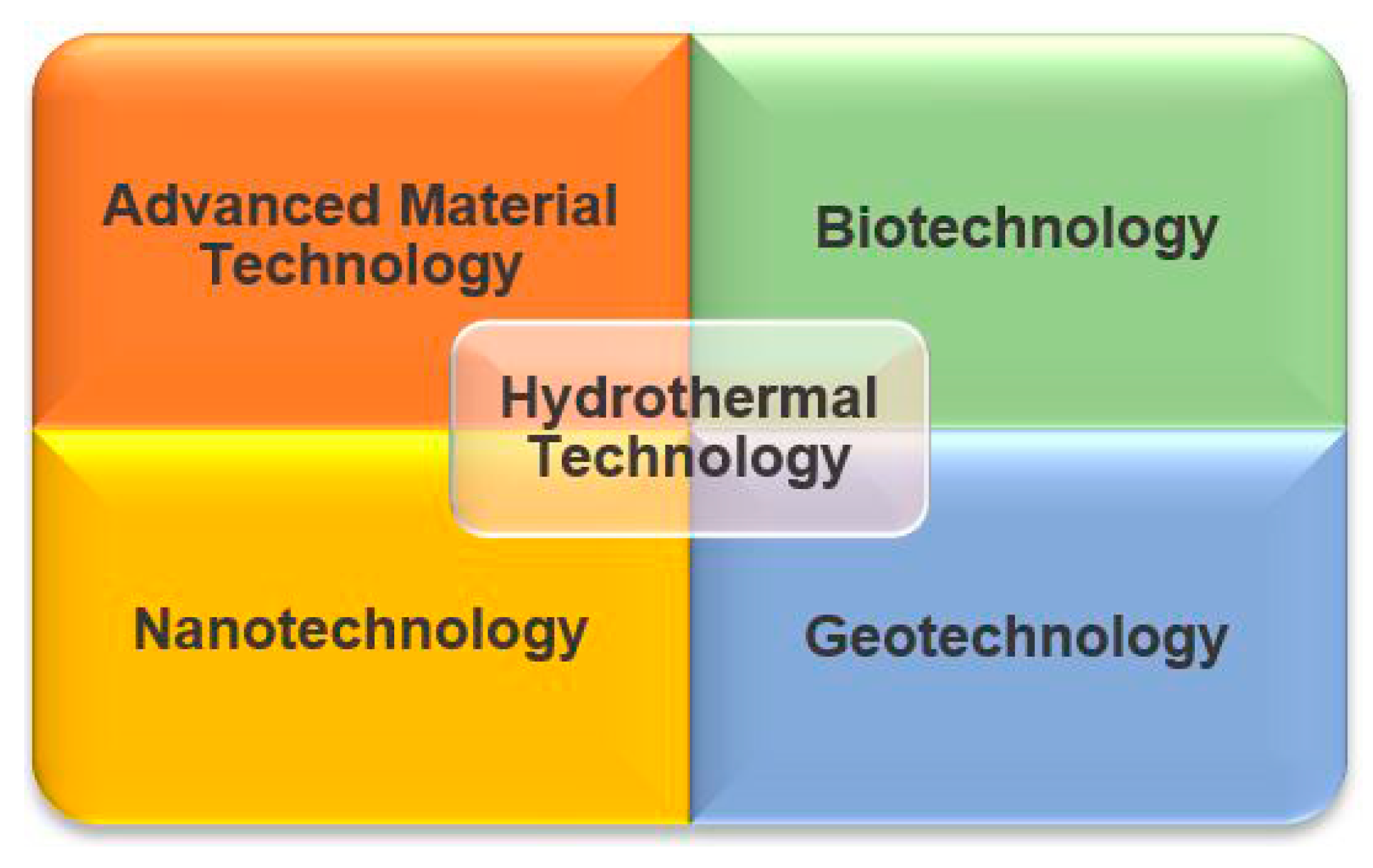

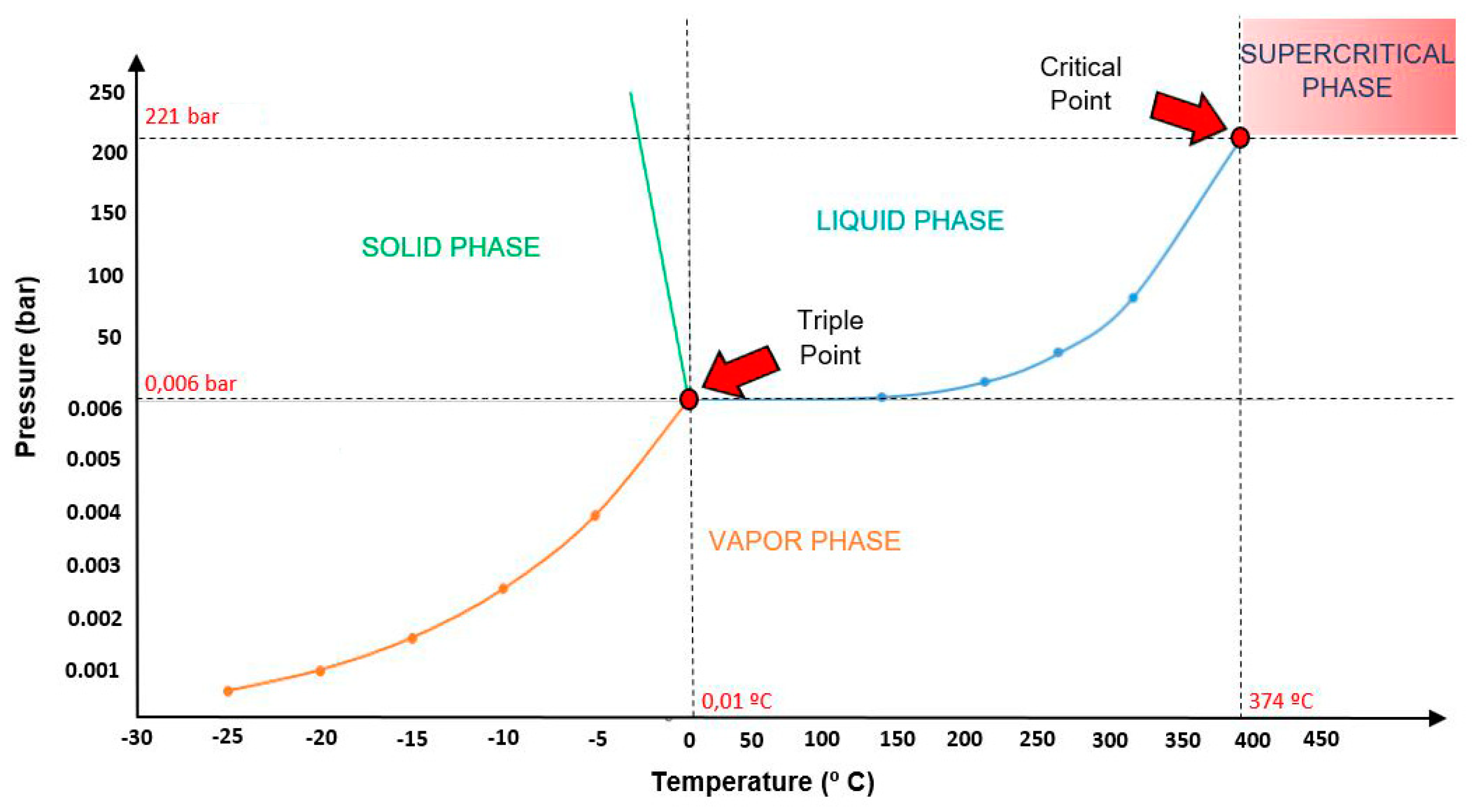

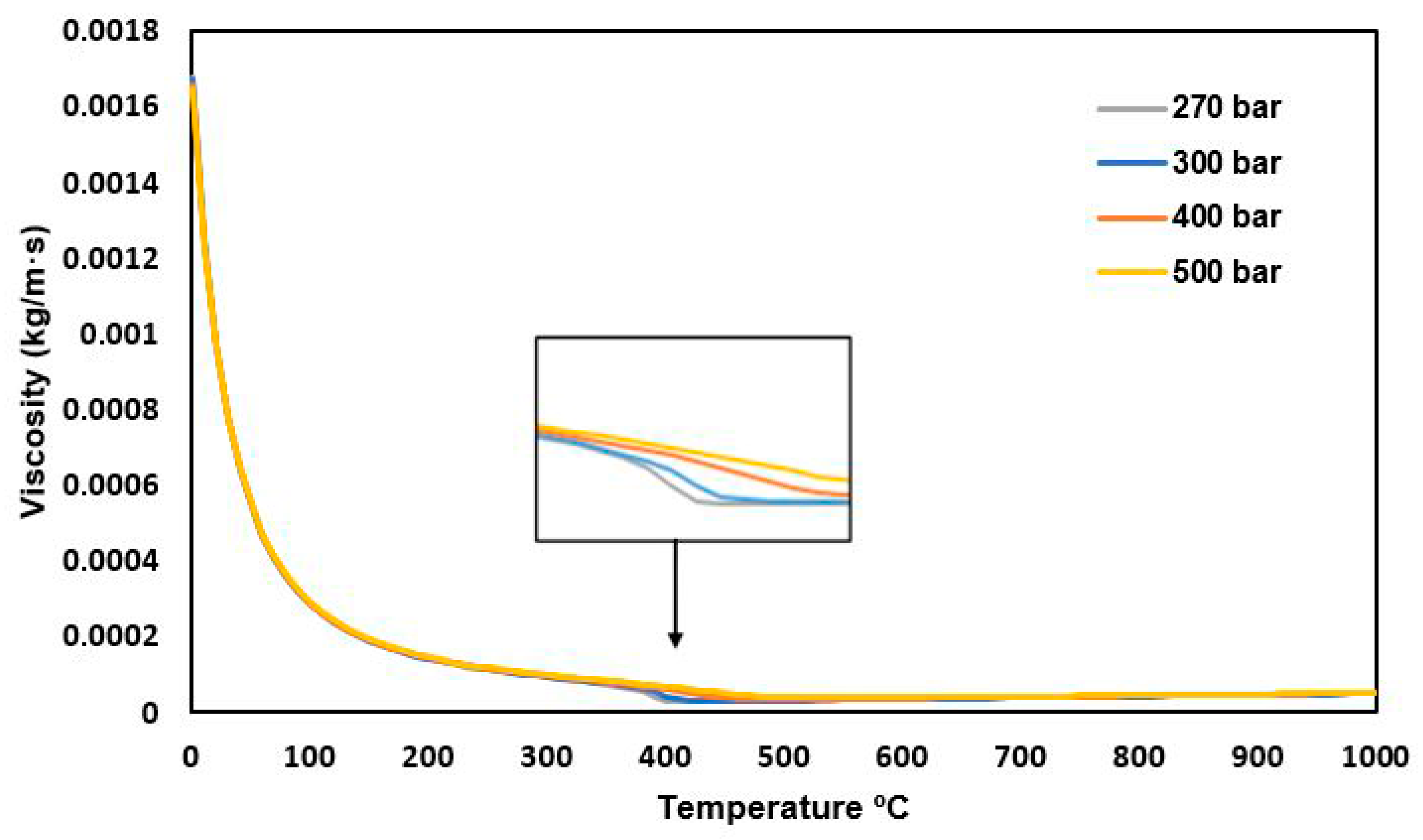

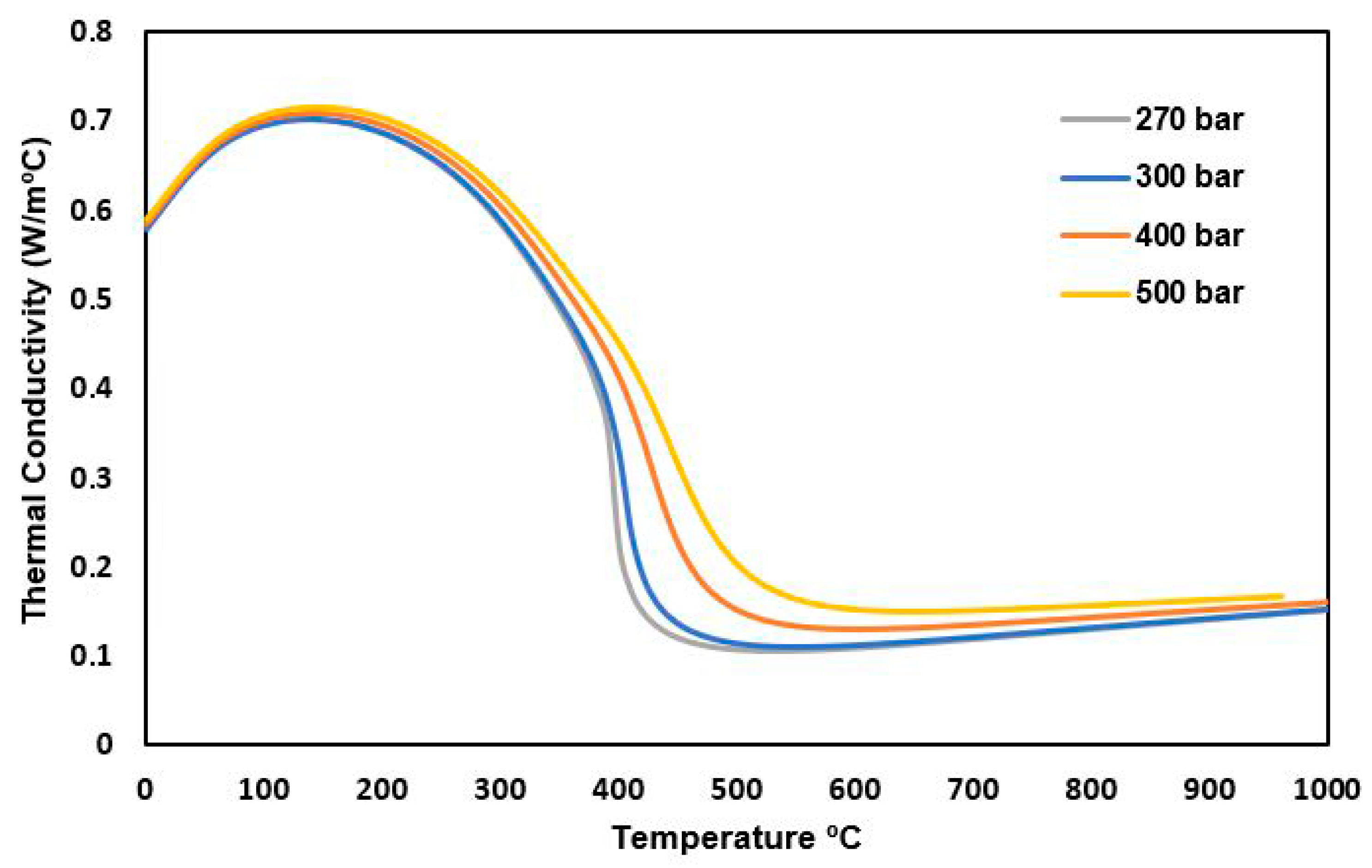
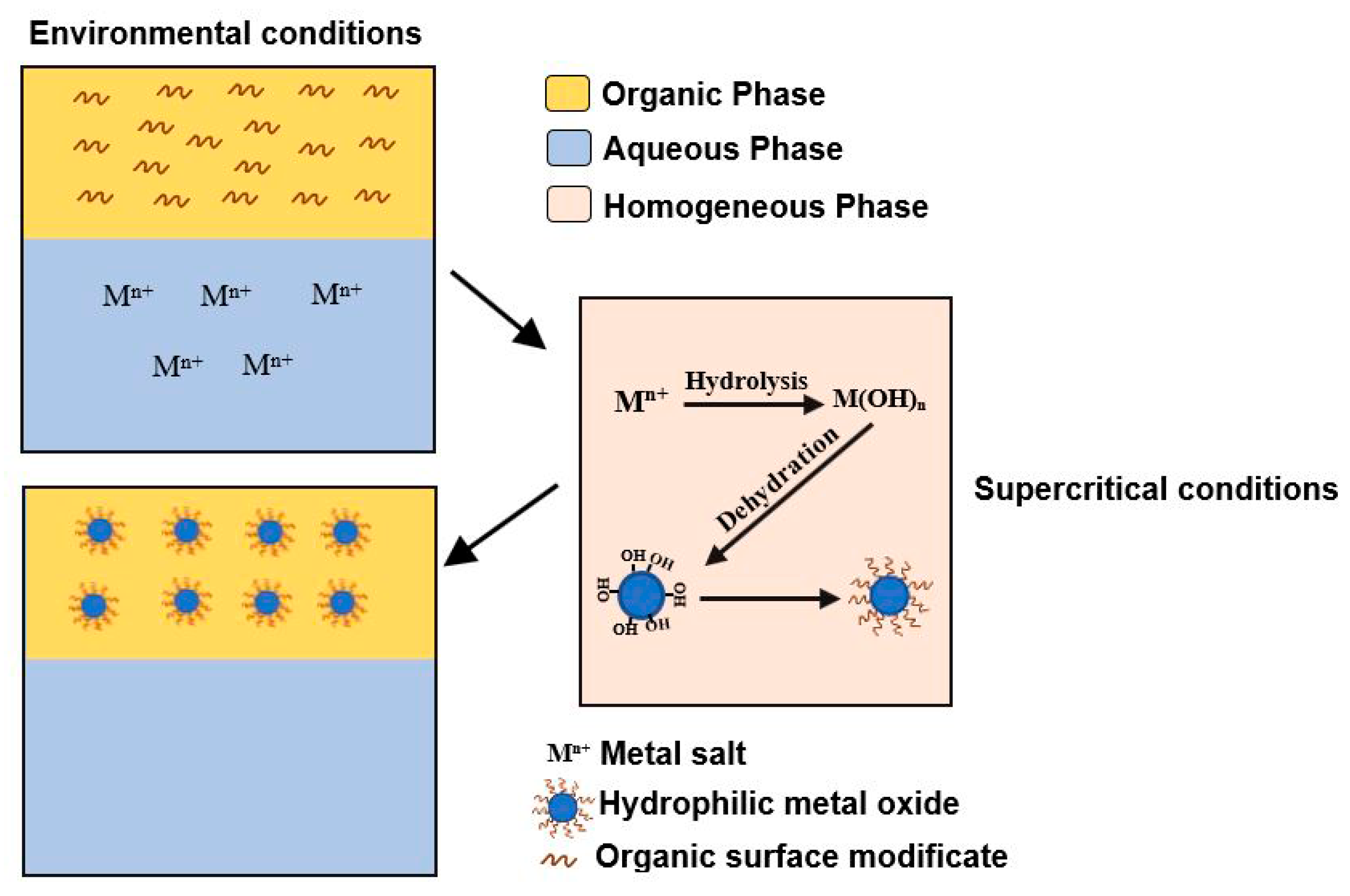

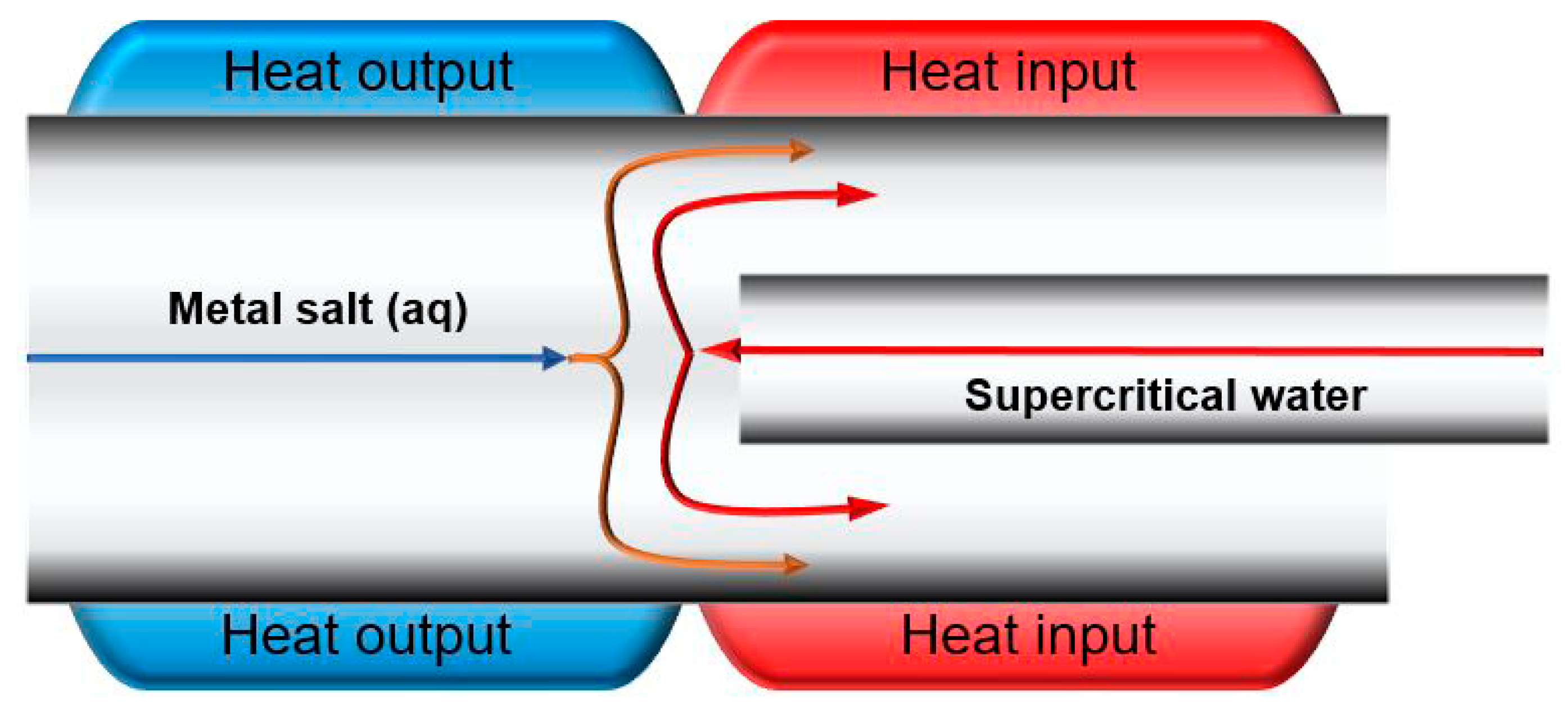
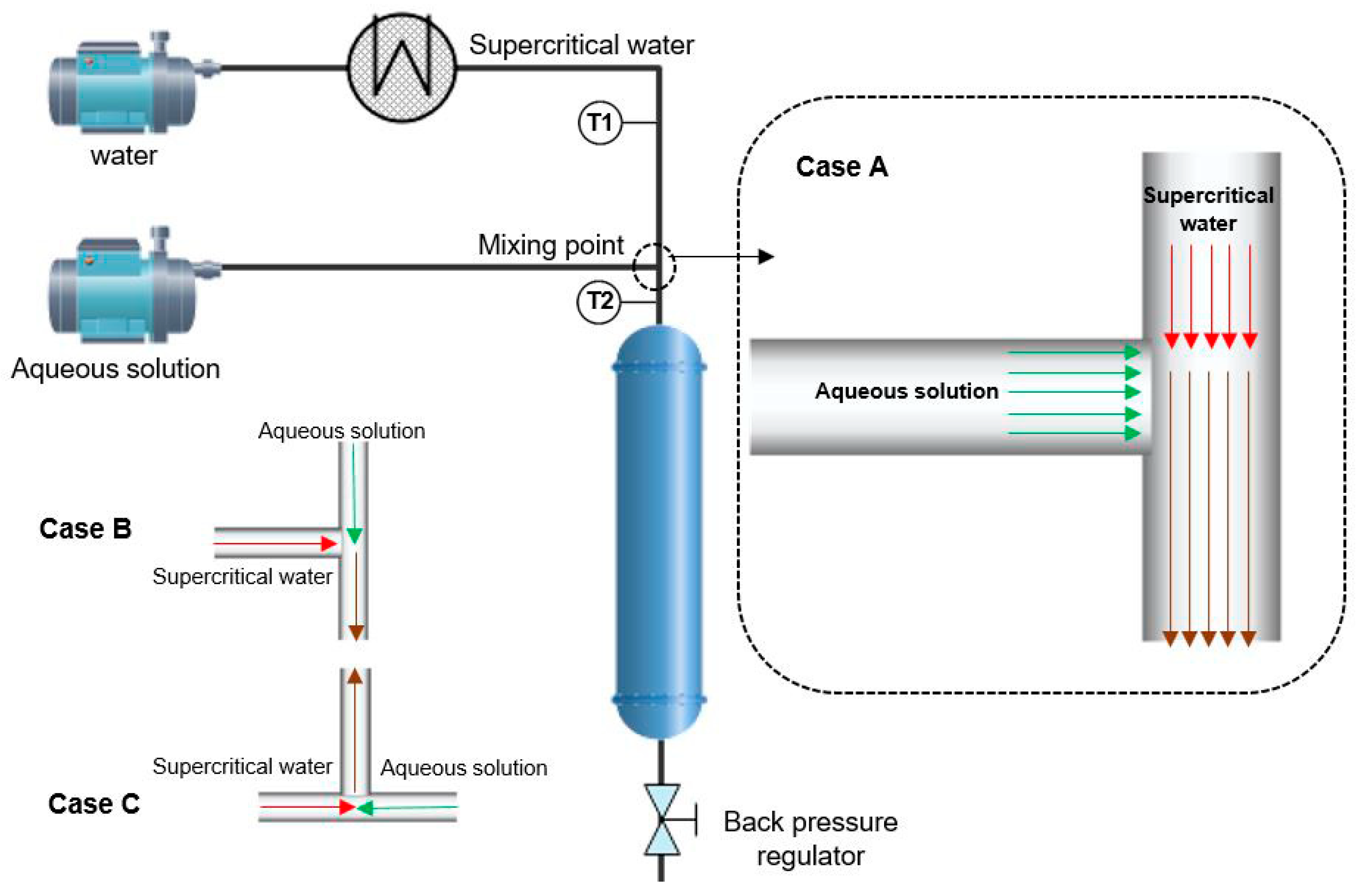
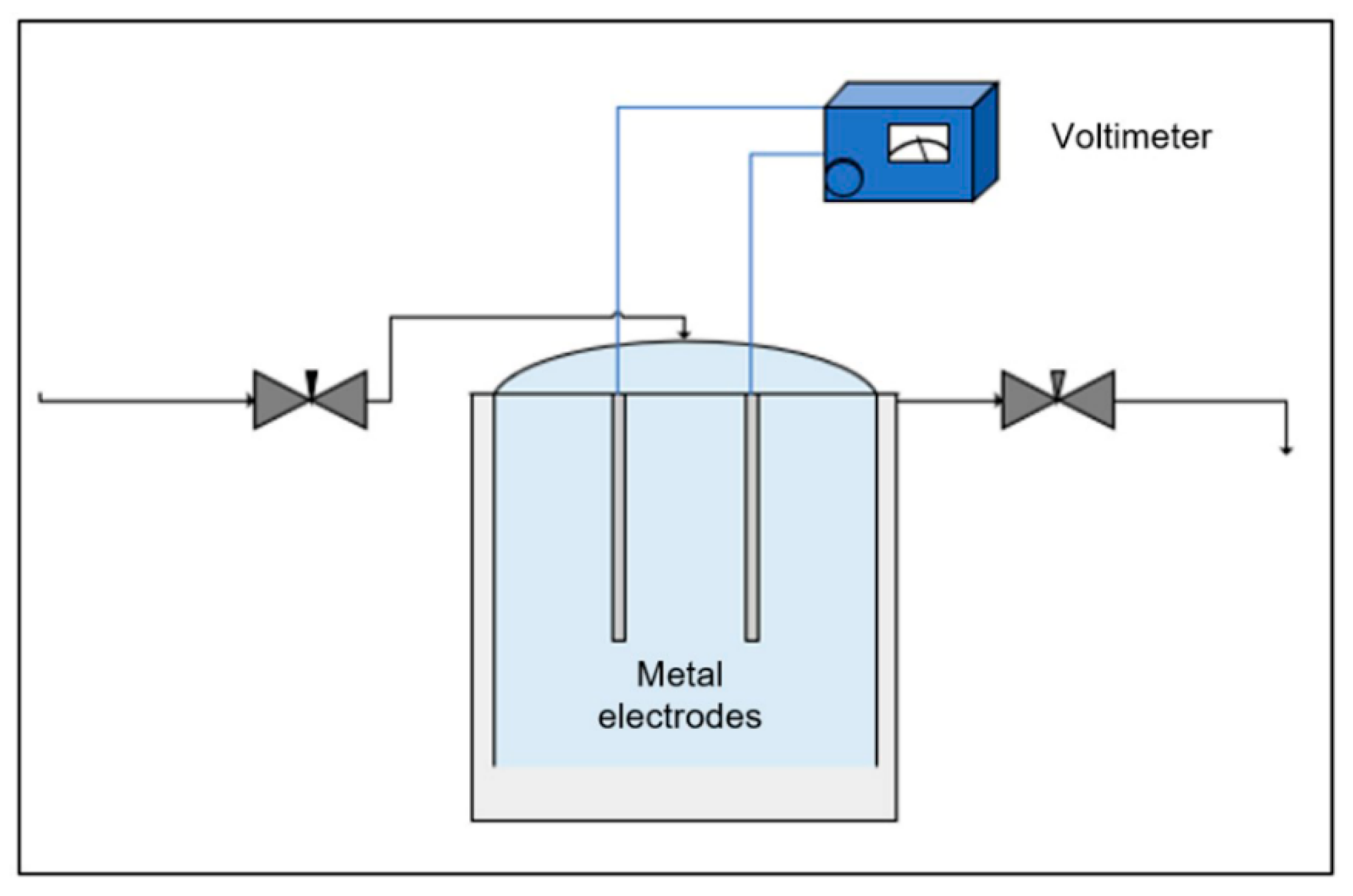
| Properties | Environmental Conditions (25 °C and 1 bar) | Subcritical Conditions (325 °C and 200 bar) | Supercritical Conditions | |
|---|---|---|---|---|
| (525 °C and 250 bar) | 650 °C and 250 bar) | |||
| Density (kg/m3) | 997.1 | 679.8 | 83.5 | 64.8 |
| Viscosity (μPa⋅s) | 890.1 | 80.5 | 31.6 | 36.4 |
| Specific heat (J/g⋅K) | 4.2 | 6.0 | 3.5 | 2.0 |
| Dielectric constant | 78.4 | 18 | 2.5 | 2.5 |
| Thermal conductivity (W/m⋅K) | 0.6 | 0.5 | 0.01 | 0.1 |
| Principal Investigators | Research Centers | Articles |
|---|---|---|
| United States | ||
| Zubieta, John A. | Syracuse University, Syracuse | [33,34] |
| Whittingham, M. Stanley | Binghamton University State University of New York, Binghamton. | [35,36] |
| Komarneni, Sridhar | University Park, The Pennsylvania State | [37] |
| Kolis, Joseph W. | Clemson University, Clemson | [38,39] |
| China | ||
| Yang, Guoyu | Beijing Institute of Technology, Beijing | [40,41] |
| Hu, Changwen | Beijing Institute of Technology, Beijing | [42,43] |
| Zeng, Wen | Chongqing University, Chongqing | [44,45] |
| Feng, Shouhua | Jilin University, Changchun | [46,47] |
| Cui, Xiaobing | Jilin University, Changchun | [48,49] |
| Shi, Zhan | Jilin University, Changchun | [50,51] |
| India | ||
| Byrappa, Kullaiah K. | University of Mysore, Vijnana Bhavan, Mysore | [52,53] |
| Natarajan, Srinivasan | Indian Institute of Science, Bengaluru | [54,55] |
| Pandurangan, Arumugam | Anna University, Chennai | [56,57] |
| Patil, Pramod Shankarrao | Shivaji University, Kolhapur | [58,59] |
| Japan | ||
| Yanagisawa, Kazumichi | Kochi University, Kochi | [60,61] |
| Adschiri, Tadafumi | Tohoku University, Institute for Materials Research, Sendai | [62,63] |
| Yoshimura, Masahiro | Tokyo Institute of Technology, Tokyo | [64,65] |
| Takami, Seiichi | Nagoya University, Nagoya | [66,67] |
| Yin, Shu | Tohoku University, Sendai | [68,69] |
| Hakuta, Yukiya | National Institute of Advanced Industrial Science and Technology, Tokyo | [70,71] |
| Hirano, Masanori | Aichi Institute of Technology, Toyota | [72,73] |
| Iran | ||
| Salavati-Niasari, Masoud | University of Kashan, Kashan | [74] |
| Haghighi, Mohammad | Sahand University of Technology, Sahand | [75] |
| Europe | ||
| Stock, Norbert | Christian-Albrechts-Universität zu Kiel, Kiel, Germany | [76] |
| Klingeler, Rüdiger | Universität Heidelberg, Heidelberg, Germany | [77,78] |
| Darr, Jawwad Arshad | University College of London, London, United Kingdom | [79,80] |
| Walton, Richard I. | The University of Warwick, Coventry, United Kingdom | [81,82] |
| Lester, Edward Henry | Nottingham University, United Kingdom | [83,84] |
| Brummerstedt Iversen, Bo | Aarhus Universitet, Aarhus, Denmark | [85,86] |
| Cyril Aymonier | The Institute of Condensed Matter Chemistry of Bordeaux, CNRS and Bordeaux University, France | [87,88] |
| Russia | ||
| Ivanov, Vladimir K. | Kurnakov Institute of General and Inorganic Chemistry, Russian Academy of Sciences, Moscow | [89,90] |
| Taiwan | ||
| Chen, Shenming | National Taipei University of Technology, Taipei, Taiwan | [91] |
| Australia | ||
| Wang, Guoxiou Xiu | University of Technology Sydney, Sydney | [92,93] |
| Features | Batch Reactors | Continuous Flow Reactors |
|---|---|---|
| Research stage | Initial | Advanced |
| Operability | Easy handing | Difficult handing |
| Reaction time | Minutes and even hours | Seconds or a few minutes |
| Heating time | Long (minutes) | Short to very short (seconds) |
| Particles size | In the order of a few microns | In the order of nanometers |
| Process control | Minor operation range | Major operation range |
| Reactor Volume (mL) | Precursors | T (°C) and P (bar) | Reaction Time | Product | Applications | References |
|---|---|---|---|---|---|---|
| 5 | ZrOCl2, KOH. Surface modifiers: PHA or PPA | T = 300 and 400; P = 300 | 10 min | ZrO2 | Highly employed in ceramic materials, biomedical devices and cutting tools, magnetic material products, artificial bone production, artificial joints, artificial teeth, and other pieces of instrument elaboration of watches. | [67] |
| 5 | Zr(OET)4 or Zr(OH)4 | T= 200–500; P = 380 | 10 min | [101] | ||
| 5 | Zr(OH)4. Surface modifiers: oleic acids, dodecanoic and 12-aminododecanoic. | T = 400; P =380 | 10 min | [102] | ||
| 8.5 | Bohemian powder and monocarboxylic acids to favor crystallization and rod formation (hexanoic, octanoic, decanoic, tetradecanoic, and octadecanoic acids). | T = 200–400; P = 300 | 10 min | ALOOH | Electronics, pharmacy, catalysis, energy storage, and medical applications. | [103] |
| 8.5 | Bohemite powder and monocarboxylic acids to favor crystallization and rod formation (hexanoic, octanoic, decanoic, tetradecanoic, and octadecanoic acids). | U.d | U.d | [104] | ||
| 5 | (Al(NO3). Reagents modifiers: hexanal and N-Hexilamina | T = 300; P = 300 | 10 min | [105] | ||
| 5 | TiO2 and Ba(OH)2 | T = 400; P = 300 | 10 min | BaTiO3 | Non-linear elements, dielectric amplifiers, memory components of electronic computers and groundwater detection devices. In addition, it can also be used to create static electricity in transformers, electronic ceramics, capacitors, and other electronic components. | [106] |
| 5 | Ce(OH)4.Surface modifiers: polyvinyl alcohol (PVA) or polyacrylic acid (PAA) | T = 400; P = 300 | 10 min | CeO2 | Removal of heavy metals from water. | [107] |
| 10 | Ce (OH)4 and monocarboxylic acids to improve crystallization (hexanoic, octanoic, decanoic, tetradecanoic, and octadecanoic acids). | T = 400; P = 380 | 30 min | [108] | ||
| 5 | Co(CH3COO)2·4H2O and formic acid as a reducing agent | T = 340, 350, 360, 380, 400 and 420; P = 221 | 10 min | Co (Metallic) | They are widely used in cement, magnetic fluids, magnetic materials, and batteries, among other uses. | [109] |
| 5 | CoSO4 (99%), Al2SO4 (55%), and NaOH. Surface modifiers: hexanoic acid and 1-hexylamine | T = 400; P = 380 | 10 min | CoAl2O4 | They have the potential to be used as pigments in special fields, including UV stabilization of plastics, transparent inks, coating on luminescent materials, etc. | [110] |
| 5 | Co(CH3COO)2·4H2O Reducing agent: formic acid and methanol | T = 350, 365, 375, 400, 425 and 450; P = 221 | U.d | CoO2 | Excellent catalyst for the Fischer-Tropsch reaction. Cobalt nanoparticles have also been used in computer storage devices, due to their high coercivity. | [62] |
| 5 | (FeSO4); Modifiers: n-decanoic acid (C9H19COOH) or n-decylamine (C10H21NH2). | T = 200; P = 10 | 10 min | Fe2O3 or Fe3O4 | They are employed in Biology and medicine. Especially in drug carriers to treat cancer. | [111] |
| 5 | Metal Salt; Modifiers: oleic acid; Reducing agent: formic acid. | T = 400 | 10 min | FePt | Information storage: it is the most promising candidate for high density storage. | [112] |
| 5 | GdNO3; Modifiers: acid 3,4dihydroxybenzenepropanoic (DHCA) and KOH. | T = 350 | 10 min | Gd(OH)3 | Catalyst: useful in the biomedical field and in neutron capture therapy. | [113] |
| 5 | (I(NO3)3 6H2O), (NH4 VO3). Modifiers: oleic acid and oleilamina | T = 300, 350 and 400 | 10 min | GdVO4 | They have interesting luminescent and magnetic properties. It can be easily doped with rare earths for different applications such as up-converter or laser. | [114] |
| 5 | Sn(OH)2, In(OH)3. Reducing agent: ethanol, formic acid. | T = 410–450; P = 230–400 | 10–60 min | indium oxide doped whit Tin (ITO) | They are often used as a coating material for display panels, solar cells, and transparent electrodes used in liquid crystal displays (LCD). | [115] |
| 5 | HfCl4 and KOH. Modifiers: DHCA. | U.d | 10 min | HfO2 | Manufacture of lenses, reflectors, optical waveguides, optical adhesives, and anti-reflective films. | [116] |
| 5 | Al(NO3), Y(NO3), and KOH. Modifiers: alquilamina (for example, oleilamina, decilamina, dodecilamina, or hexadecilamina). | T = 420; | 10 min | YAG | Excellent candidate as host material in solid state lasers | [117] |
| 10 | 1.2-phenylenediamine and benzoic acid | T = 100–400; P = 1–574 | U.d | 2- phenylbenzimidazole | They can act as ligands to the transition metals for the modeling of biological systems. Moreover, they can be used to treat parasitic diseases. | [118] |
© 2020 by the authors. Licensee MDPI, Basel, Switzerland. This article is an open access article distributed under the terms and conditions of the Creative Commons Attribution (CC BY) license (http://creativecommons.org/licenses/by/4.0/).
Share and Cite
Ruiz-Jorge, F.; Portela, J.R.; Sánchez-Oneto, J.; Martínez de la Ossa, E.J. Synthesis of Micro- and Nanoparticles in Sub- and Supercritical Water: From the Laboratory to Larger Scales. Appl. Sci. 2020, 10, 5508. https://doi.org/10.3390/app10165508
Ruiz-Jorge F, Portela JR, Sánchez-Oneto J, Martínez de la Ossa EJ. Synthesis of Micro- and Nanoparticles in Sub- and Supercritical Water: From the Laboratory to Larger Scales. Applied Sciences. 2020; 10(16):5508. https://doi.org/10.3390/app10165508
Chicago/Turabian StyleRuiz-Jorge, F., J. R. Portela, J. Sánchez-Oneto, and E. J. Martínez de la Ossa. 2020. "Synthesis of Micro- and Nanoparticles in Sub- and Supercritical Water: From the Laboratory to Larger Scales" Applied Sciences 10, no. 16: 5508. https://doi.org/10.3390/app10165508






